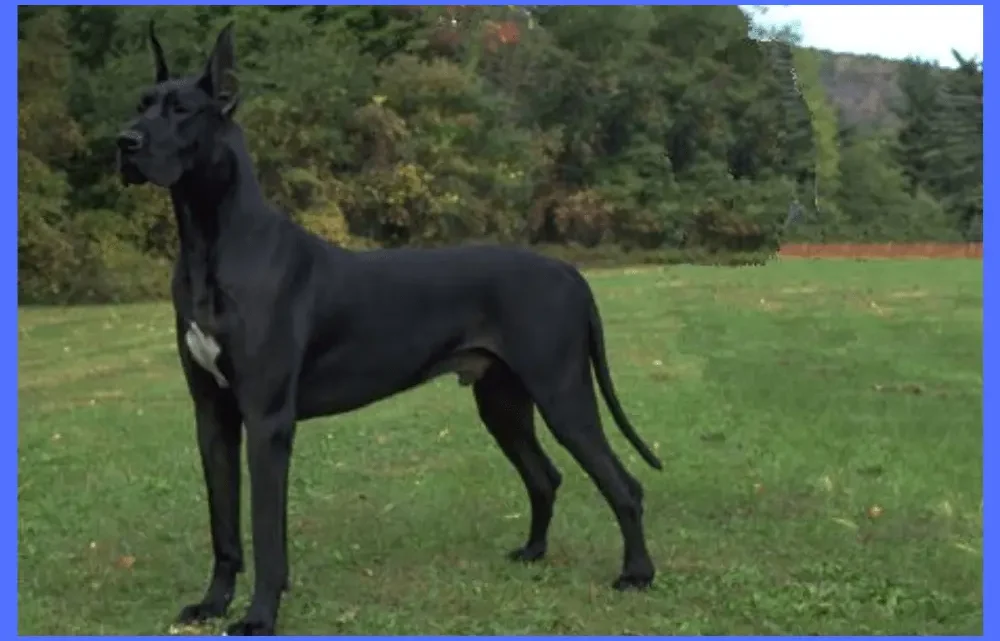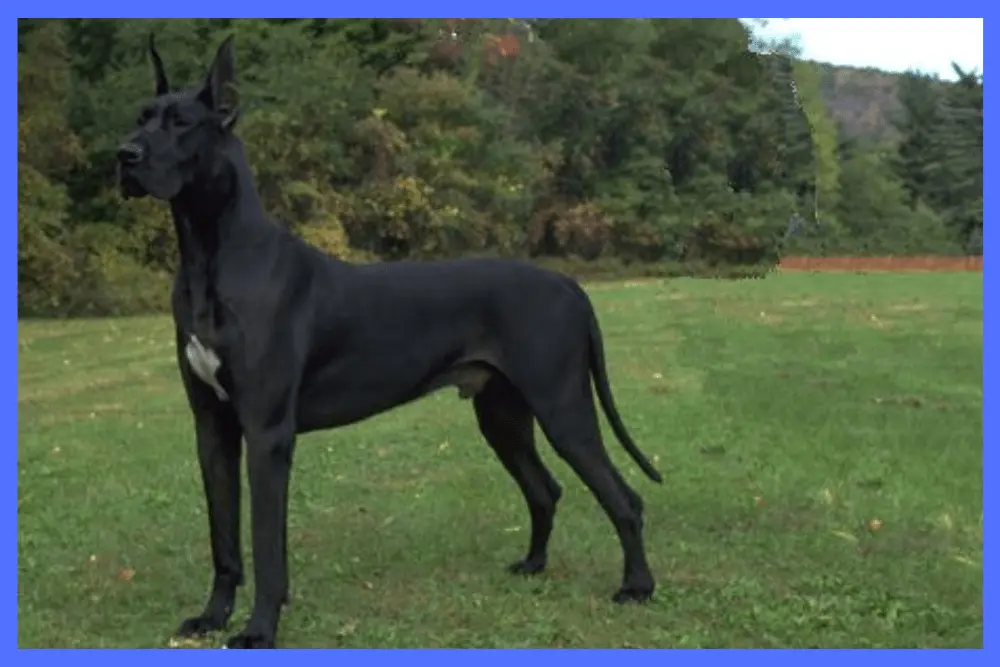
Black Great Dane Dog: Characteristics, Care & Training Tips for the Perfect Companion
What is a Black Great Dane Dog?
The black Great Dane dog is one of the most striking and elegant variations of the iconic breed. Known for their large size and regal presence, Black Great Danes stand out with their sleek, dark coats. While they share many traits with other Great Danes, their color plays a major role in how they’re perceived. These dogs aren’t just about looks — they have a calm, gentle nature that makes them great companions.
In terms of appearance, Black Great Danes are large, muscular dogs, often weighing between 110-175 pounds. They can reach heights of up to 32 inches at the shoulder. As for behavior, they are known for being affectionate, social, and patient with families, making them excellent pets for both active households and those seeking a more laid-back companion. When compared to other Great Dane colors, the black variety doesn’t differ much in terms of temperament or health, but their unique, deep black coat makes them stand out in the breed.

Characteristics and Physical Traits of a Black Great Dane
A black Great Dane is the definition of elegance. They’re big, bold, and undeniably imposing. Standing at an average height of 28-34 inches at the shoulder, these dogs are giants. Black Great Danes are often described as “gentle giants”, not just for their size, but also for their calm, loving nature.
So, what are the physical traits that set them apart?
Coat and Color:
The standout feature of a black Great Dane is its solid black coat. Unlike the variations you see in other Great Danes, such as brindle or fawn, black Danes have no patterns or markings—just a clean, deep black that shines under the light. The fur is short and smooth, requiring minimal grooming. The coat is one of the breed’s most striking features, often mistaken for a black panther in some lighting.
Size and Build:
Known as the “Apollo of dogs,” the Black Great Dane is massive. Males can reach heights of 30-34 inches at the shoulder and weigh up to 175 pounds. Females are slightly smaller but still commanding in size. Their large size is paired with a muscular build, contributing to their graceful and powerful appearance. Despite their size, they often appear sleek and agile, like a giant athlete.
Head and Expression:
The head is broad with a pronounced square jawline, giving the black Great Dane a noble, regal appearance. Their eyes, often dark, are wide-set and communicate a calm yet alert expression, showing intelligence and curiosity.
How does a black Great Dane compare to other colored Great Danes?
While all Great Danes share a similar size, build, and gentle temperament, the black Great Dane is particularly known for its bold appearance. The major difference between the black variety and others, like fawn or brindle, is purely cosmetic. The black coat is uniform and deep, whereas other color variations might include patterns or lighter hues.
In terms of behavior, size, and health, there’s no difference. All Great Danes, regardless of their coat color, are known for being friendly, affectionate, and loyal. However, appearance is the defining factor when comparing black Danes to the other colors.
Personality and Behavior of a Black Great Dane
What is the typical temperament of a Black Great Dane?
The Black Great Dane has one of the most gentle and affectionate personalities you’ll find in a dog of such size. These dogs are known for being calm and friendly, but don’t let their size intimidate you—despite their imposing stature, they’re usually sweet-natured.
Black Great Danes are social dogs. They crave attention and love being with their humans, whether that’s lounging on the couch or playing in the yard. They’re not the type to enjoy being alone for long periods, so they’re best suited for families who can give them plenty of time and affection. Often, they’re called “gentle giants” because of their laid-back, yet protective demeanor.
Are Black Great Danes good with children and other pets?
Yes! Black Great Danes are known for being patient and tolerant, especially with kids. They’re typically gentle around children, even though their large size means caution is needed to prevent accidental bumps or knocks. That said, they’re generally well-behaved and understand their strength, making them ideal for families with young ones.
When it comes to other pets, Black Great Danes tend to get along well with other dogs and animals, provided they’re properly socialized. They are not aggressive by nature, but like any breed, early socialization is key to ensuring they get along smoothly with other pets, particularly smaller animals. Their calm and peaceful nature typically makes them good companions for other dogs.
You may like to read here:
Best Dog Breeds Similar to Great Dane: Find Your Perfect Match

Health Considerations and Lifespan of Black Great Danes
Are Black Great Danes prone to specific health issues compared to other Great Danes?
When it comes to health, Black Great Danes aren’t significantly different from other color variations of the breed. However, like all Great Danes, they are prone to some common health issues due to their large size. A few things to keep in mind:
- Hip Dysplasia: Common in large breeds, this is a condition where the hip joint doesn’t develop properly, causing pain and mobility issues.
- Gastric Dilatation-Volvulus (GDV): Often referred to as bloat, this is a life-threatening condition where the stomach twists. It’s more common in deep-chested dogs like Great Danes.
- Heart Problems: Due to their size, Great Danes can suffer from cardiomyopathy (a condition that affects the heart muscles), leading to heart failure in some cases.
The Black Great Dane doesn’t face any unique health risks because of its coat color. However, all Great Danes, regardless of color, need to be monitored for these conditions.
What is the average lifespan of a Black Great Dane?
Black Great Danes typically live between 7 to 10 years. This shorter lifespan is common in large dog breeds, as they age faster than smaller dogs. To help extend their life, regular veterinary checkups, a balanced diet, and exercise are crucial.
Key Health Concerns:
Heart Health: Regular check-ups to catch signs of heart disease early are important.
Bloat (GDV): Always monitor your Dane after meals and avoid heavy activity right after eating.
Joint Issues: As they age, Great Danes can develop arthritis or hip dysplasia, so joint supplements and moderate exercise can be beneficial.

Training a Black Great Dane: Tips and Challenges
What are the best strategies for training a Black Great Dane?
Training a Black Great Dane is all about patience, consistency, and understanding their size and personality. Here are some strategies that work well:
- Start Early: Begin training as a puppy to build good habits. The earlier you start, the easier it will be.
- Positive Reinforcement: These dogs respond best to reward-based training. Use treats, praise, or toys to encourage good behavior.
- Socialization: Introduce your Dane to different people, environments, and other animals. The more experiences they have, the more well-rounded and adaptable they’ll be.
- Short Sessions: Keep training sessions short and focused—Black Great Danes can get bored with long, repetitive training.
- Leash Training: Since they’re large and strong, teaching your Dane to walk on a leash without pulling is essential. Start early and use a harness for better control.
Are there any specific behavioral traits that affect training?
Black Great Danes are known for being gentle and calm, but their size can make training challenging, especially if they’re not taught proper manners early on. Here’s what to keep in mind:
Loyalty: Danes are incredibly loyal, which means they usually want to please you. Use this to your advantage during training—once they know you’re the leader, they’ll fall into line.
Stubbornness: Like many large breeds, Danes can sometimes be a bit stubborn. They won’t necessarily do something just because you ask—especially if they don’t see the point. Patience is key.
Distraction: They tend to get distracted easily. Their size can also make them less focused during training, so keep distractions to a minimum in the beginning.
Care and Maintenance of a Black Great Dane
What kind of grooming and coat care does a Black Great Dane require?
Grooming a Black Great Dane is pretty straightforward. Their short coat doesn’t need constant attention, but you’ll still need to keep up with a few key tasks:
- Brushing: Once a week is enough. Use a rubber brush or a hound glove to remove loose hairs. This helps reduce shedding and keeps their skin healthy.
- Bathing: Black Great Danes don’t need frequent baths. Bathe them as needed—typically when they get particularly dirty or start to smell. Use a mild dog shampoo to keep their skin from drying out.
- Ear Cleaning: Check their ears once a week for wax build-up or dirt. Clean with a damp cloth or pet-safe ear cleaner to avoid infections.
- Nail Trimming: Keep their nails trimmed, especially since they’re large. Trim them regularly to prevent discomfort and ensure they walk properly.
How much exercise does a Black Great Dane need?
Black Great Danes are active, but since they’re giants, their exercise needs are a bit different from smaller dogs. Here’s what you need to know:
- Daily Exercise: Aim for 30-60 minutes of exercise daily. This can include walks, light jogging, or playtime. They need moderate exercise to stay healthy but avoid overexerting them—especially as puppies.
- Space: These dogs do better in homes with lots of space. If you have a yard, that’s great. But don’t expect them to get enough exercise in a small apartment.
- Mental Stimulation: Since they’re intelligent, they need mental stimulation too. Interactive toys, training, and even puzzle games help keep them engaged and avoid boredom.
- Diet: Their large size means they need a high-quality diet to stay healthy. Watch their weight—obesity can lead to joint problems and other health issues.
Myths vs. Facts: What People Get Wrong About Black Great Danes
What are the common misconceptions about Black Great Danes?
Black Great Danes are often misunderstood. Here are some common myths:
Myth 1: Black Great Danes are more aggressive.
Fact: The color of a Great Dane’s coat doesn’t determine its temperament. Black Great Danes are just as calm, friendly, and gentle as other color variants like fawn or brindle. Their large size can make them appear intimidating, but in reality, they’re known for being affectionate and loyal.
Myth 2: Black Great Danes are more prone to health issues.
Fact: The coat color doesn’t affect their health. Black Great Danes face the same health concerns as other Danes, such as hip dysplasia and bloat, but these issues are linked to their size, not their color.
Myth 3: Black Great Danes require more grooming than other Danes.
Fact: Their grooming needs are actually minimal. The black coat is sleek and easy to maintain with regular brushing. Unlike long-haired breeds, they don’t require constant grooming.
Is there any truth to the belief that Black Great Danes are more aggressive than other colored Great Danes?
No, there’s absolutely no truth to this. Aggression in dogs, including Black Great Danes, is primarily influenced by their environment, socialization, and training—not their coat color. Black Great Danes tend to be mild-mannered and sociable, making them great companions for families. In fact, many Black Danes are known for being especially gentle with children and other pets.
It’s important to note that early socialization and consistent training are key factors in shaping any dog’s behavior. A well-trained Dane, regardless of color, will typically be friendly and approachable.
Should You Choose a Black Great Dane as a Pet?
What are the pros and cons of adopting a Black Great Dane?
Pros:
- Gentle Giant: Black Great Danes are often called “gentle giants” for a reason. Despite their massive size, they’re calm, affectionate, and great with families.
- Loyal Companions: They form deep bonds with their owners and are incredibly loyal. If you’re looking for a dog that will be by your side, a Black Great Dane fits the bill.
- Low Grooming Needs: Their short coat means you won’t spend a lot of time grooming. A weekly brush and occasional bath is all they need.
- Great with Kids: Black Great Danes are known for being patient with children. Their size can be intimidating, but they’re usually very gentle around little ones.
Cons:
- Space Requirements: They’re large dogs, and they need space to move around. A small apartment might not be the best fit unless you can give them enough exercise.
- Health Issues: As with any giant breed, they’re prone to certain health problems like hip dysplasia and bloat. They also have a shorter lifespan (7–10 years on average).
- Exercise Needs: While they’re not hyperactive, they still need regular exercise. You’ll need to commit to daily walks and playtime.
- Size and Strength: Their size can be overwhelming at times. It’s important to have the strength and patience to manage them, especially when they’re still puppies.
Is a Black Great Dane the right fit for your family and lifestyle?
If you have the space and are ready for a dog that requires a bit of extra care due to their size and health needs, a Black Great Dane could be an amazing addition to your family. They thrive in homes with enough room to roam and a family who can give them plenty of attention and affection.
However, if you’re looking for a low-maintenance dog that doesn’t require much exercise or space, a Black Great Dane might not be the best choice. They’re a commitment, but if you’re up for it, they’ll be a loyal, loving companion for years to come.
Conclusion: Why a Black Great Dane Might Be the Perfect Dog for You
A Black Great Dane could be the perfect pet if you’re looking for a loyal, gentle giant who’s great with families. Their calm nature and affectionate temperament make them ideal companions for those with enough space and time to care for them. While they require regular exercise and attention, their low grooming needs and easygoing behavior more than make up for it. If you can handle their size and health considerations, a Black Great Dane dog will reward you with unwavering loyalty and an amazing presence in your home.
📚 Sources
- American Kennel Club (AKC) – Great Dane breed profile and standards
👉 https://www.akc.org/dog-breeds/great-dane/ - PetMD – Great Dane breed health concerns and care tips
👉 https://www.petmd.com/dog/breeds/c_dg_great_dane - VCA Hospitals – Veterinary care and health issues for Great Danes
👉 https://vcahospitals.com/know-your-pet/great-dane - The Kennel Club (UK) – Breed standards for the Great Dane
👉 https://www.thekennelclub.org.uk/services/public/find-a-breeder/secure-a-puppy/breeds/a-to-z - Great Dane Rescue – Adoption information and Black Great Dane specifics
👉 https://www.greatdanerescue.org


